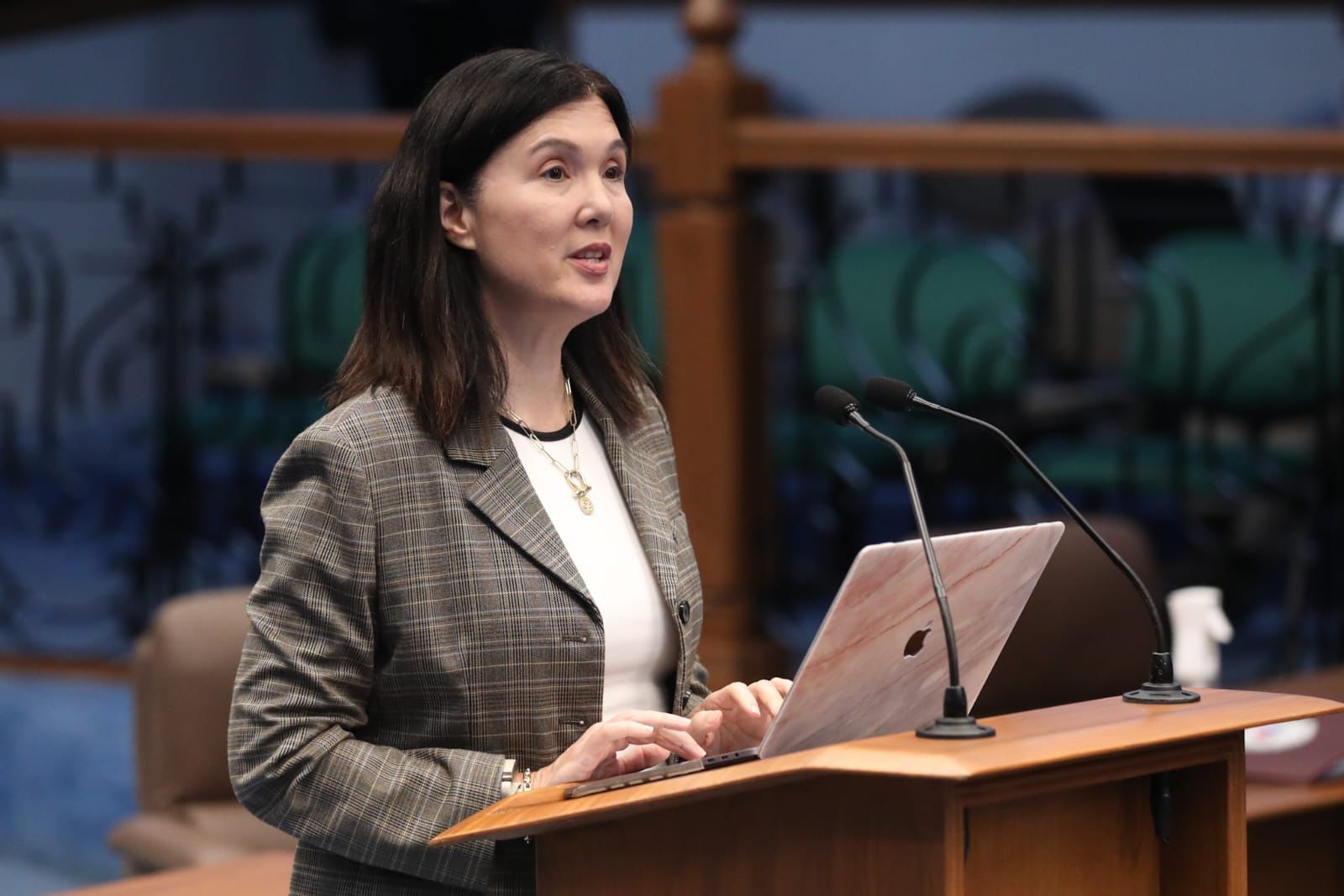Mr. President, I rise to sponsor Senate Bill No. 2793, under Committee Report No. 304, or the Philippine Natural Gas Industry Development Act.
The Philippine Energy Plan 2023-2050 agenda aims to “achieve inclusive and sustainable development propelled by modern and clean energy technologies.”
This energy framework recognizes the importance of transitioning to cleaner, more resilient, and sustainable energy systems.
At the core of this energy plan is the promotion and integration of renewable energy, with the goal of having 50 percent or half of the country’s energy generated from renewable resources by 2040.
A brief Philippine energy history… Interestingly, for many years, 100 percent of our energy source was renewable energy. In the 1930s to 1980s, there was a transition in the country, from sourcing its electricity from 100 percent renewable energy to a mix of renewable energy, fossil fuel, and nuclear energy. And then we were hit by the power crisis. In the 1990’s to 2001, the Philippine power crisis led to the enactment of two laws: RA 7638, which established the Department of Energy (DOE) in 1992; and the Electric Power Crisis Act of 1993, which was later restructured to RA 9136 or the Electric Power Industry Reform Act of 2001, otherwise known as EPIRA. This law created the Energy Regulatory Commission (ERC). From 2001 to 2022, there was a transition back to green energy. The Philippines renewed its commitment to using clean energy sources.
The Clean Energy Scenario, which was set in the Philippine Energy Plan, aims for 35 percent of renewables by 2030 and up to 50 percent by 2040. From 2022 to the present, energy transition is occurring across multiple levels.
However, based on the 2022 Primary Energy Mix from the Department of Energy, majority or 63.2 percent of the country’s energy are sourced from oil and coal: Oil is 32.2 percent; Coal is 31 percent; Geothermal at 14.6 percent; Biomass at 12.6 percent, Natural Gas at 4.2 percent, Hydro at 4.1 percent; and Other Renewable Energy at 1.4 percent.
We are clearly vulnerable to geopolitical conflicts with more than half of our energy requirements being imported.
As the country moves towards renewable energy sources, we need to find additional baseload resources, aside from oil and coal, which are less harmful to the environment and less volatile to international conflicts.
Natural gas as transitional fuel… Natural gas will act as our transition or bridge fuel, shifting our reliance from fossil fuels to our goal of generating renewable energy from diverse sources.
While the renewable energy industry is developing, natural gas can help decrease our dependence on imported coal and oil. The growth in renewables requires a growth in natural gas. It will enable the country to manage the transition to clean energy without having to sacrifice economic performance.
On Malampaya… In 1972, the Oil Exploration and Development Act was signed into law, which provides the legal basis for the development of the indigenous petroleum resources.
Within a few years of its enactment, more than 150 wells were drilled and a couple of these wells led to the discovery of a gas field near Palawan, which is now known as the Malampaya Project.
During 1976-1989, there was a notable increase in the number of drilling operations, peaking in the late 1970’s. This marked the period of the significant discovery of natural gas in the Philippines.
But over the past decades, there has been a decline in exploration activities. The last significant discovery was the Camago Malampaya reserve, discovered in 1992 and initially drilled in 1989. As of now, the drilling of two development wells is currently in its preparation phase and set to start in 2025. They hope the new wells can start producing gas by 2026.
With the renewal of the Service Contract 38, the number of drilling operations is expected to increase to ensure the continued operation and production of natural gas in the Philippines.
Unfortunately, the level of interest in exploring for gas has diminished significantly. From more than 150 wells in the 1970’s, only 11 were drilled in the late 1990’s then down to 6 in the past administration. Due to the lack of drilling exploration since 2019, no new discoveries have been made.
Compared with other Southeast Asian countries, the Philippines ranks the lowest, having no natural gas discoveries in the past decade. Meanwhile, Indonesia, which has made significant efforts of exploration drilling, ranks second in terms of natural gas resource discoveries.
Malampaya has been a central figure in our energy security, having been supplying stable-cost gas to power much of Luzon’s energy requirements for more than 20 years. It is the country’s only natural gas field, which was discovered back in 1989, and started operations in 2001. Malampaya powers 20% of Luzon. It is also responsible for remitting more than $13.5 billion worth of revenue to the Philippine government, or roughly $680 million annually since its inception. Sixty percent of the revenue from indigenous gas is remitted to the government. For every peso of electricity fueled by Malampaya, 40 to 60 centavos is returned to the government as revenue.
Malampaya was supposed to be the first of many producing gas fields in the Philippines but it turned out to be the only one. It has grown old, and may become depleted as early as 2027. This poses a dilemma. To support the DOE’s long-term energy plan, the country needs more Malampayas: we barely have one left.
The proposed measure aims to develop the natural gas industry which is critical to energy security by revitalizing indigenous gas explorations, and developing Liquified Natural Gas or LNG infrastructures. This bill provides for the prioritization of indigenous gas over other imported LNG and other conventional fuels in terms of use and the production of power.
Similar to our discussion on the Corporate Recovery and Tax Incentives for Enterprises, the CREATE Law and now, in the CREATE MORE, we always emphasize investors’ confidence in our country through the policies that we established. Prioritizing indigenous gas in procurement and utilization will also give assurance to investors that they have a market to sell it. When investors make the decision to spend hundreds of millions of dollars to drill a well that has, at best, a 10 percent chance of producing gas, investors would need the assurance that they have the market to sell it.
Kapag ang mga investor ay nagdesisyon maglaan ng daan-daang milyong dolyar para mag-drill ng balon na may sampung porsyento lamang na tsansa na makapag-produce, makapaglikha ng gas, kailangan nilang masiguro na may siguradong bibili nito.
This is not a battle between indigenous gas and imported gas. Given our country’s future energy needs, the supply of indigenous gas, like it or not, may not be enough.
This bill covers all aspects of the natural gas industry, including, transportation, transmission, and storage, among others. This ensures adherence of the natural gas operations to both the international and local best practices.
We would still need to import LNG to cover any shortfalls in indigenous gas supply, which this bill will ensure through the development of LNG infrastructures.
The proposed measure also includes incentives for investments aimed at developing the natural gas industry in the Philippines.
To conclude, we will not be as vulnerable regarding fluctuating energy prices due to events happening halfway across the world. With Filipino gas, we will not be heavily dependent on foreign suppliers, who may suddenly pull out of the Philippines to sell their gas to richer buyers elsewhere. Filipino gas will give us a significant measure of energy security and sovereignty underpinning our economic development.
Mr. President, my esteemed colleagues, this law will provide a blue path to a greener future. Filipino gas for the Filipino people. I ask that you support its immediate passage. Thank you. #


Leave a Reply